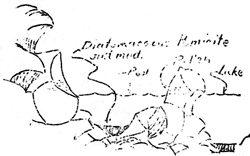|
Volume VI No. 4 - September, 1933
The Pools Of Wizard Island
By Ranger-Naturalist J. S. Brode
Wizard Island affords a great deal of interesting material for both
geological and biological reflection. Many feet tread the trail up the
extremely fascinating cinder cone of the island. Relatively few, aside
from an occasional fisherman seeking the Skell Channel, tread the
rock-piled ramifications of the island to the west of the cone. On this
portion of the island erosion has made but little progress. Rough folds
of lava rocks have cracked into innumerable jagged blocks of stone that
have tumbled into loose jumbled masses. So sharp and angular are the
blocks that the whole mass permits the water falling on it to drain
readily through it down to the lake level. This same condition permits
the waters of the lake to flow through there rock masses at the level of
the lake.

As a result of this water table or level, a level fluctuating with
the level of the lake, there exist in the hollows between the jagged
lava rock piles a number of pools, the size and especially the depth of
these pools being determined by the extent to which the collapsed
sputter cones developed depressions with a base below the present water
level.
On looking at these pools from the Watchman or from the Rim Drive,
one observes light green patches which would indicate to the observer
the possibility of the existence of beds of algae such as
Spirogyra. A visit to the pools, however, reveals a lack of
green algae. The patches turn out to be an accumulation of a creamy
white mud and ooze. Similar accumulations occur in Skell Channel and
between the rocks off the shore of Wizard Island. A carefully
examination of samples from a number of these accumulations indicates
that they are a highly diatomaceous pumicite sediment.
During the latter part of July the White bark pines (Pinus
albicaulis) throw off to the wind a vast amount of pollen. This
pollen accumulates in floating bands of yellow which moved about the
lake, eventually contacting the shore, where the pollen tended to adhere
to the rocks at the shoreline. As the waters of the lake evaporate the
pollen is left in rings on the shore rocks. A small amount of the
pollen apparently becomes water-logged, or by wave action, gets
entangled in the diatomaceous slime on the rocks as a microscopic
examination of the rock scrapings indicates their occasional presence.
Samples two or three feet down do not show the presence of pollen, hence
the reasonable conclusion that the coloration in the shallow portions of
the lake is the result of diatomaceous ooze or slime mingled with pumice
dust.
| 
